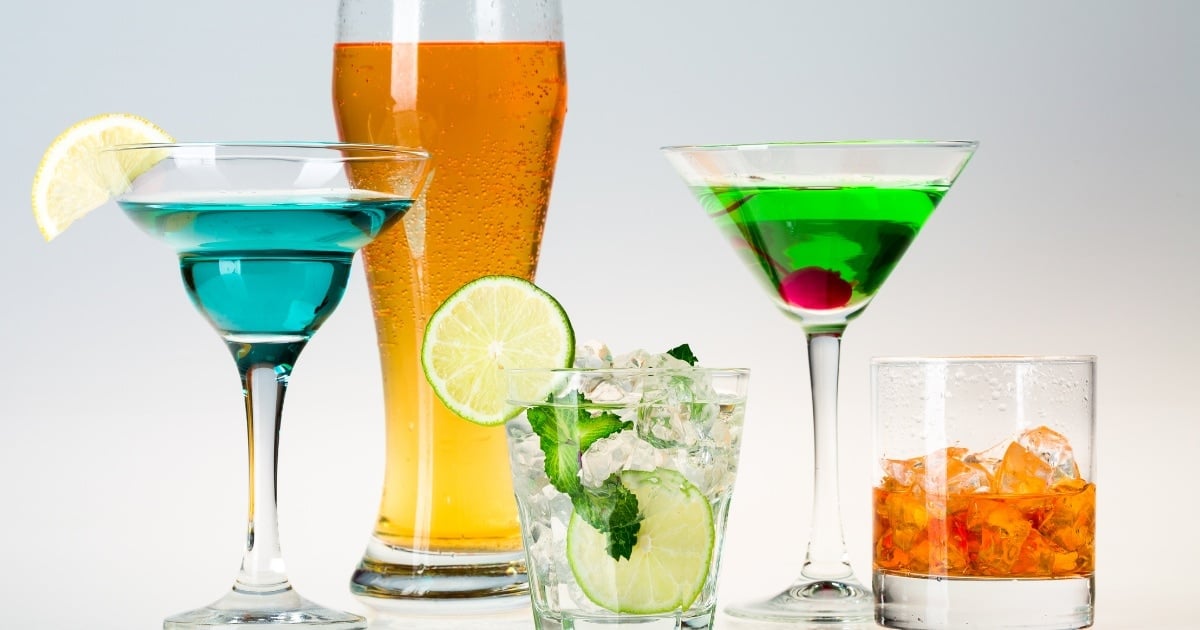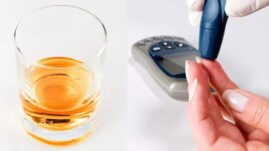If you have diabetes, you might be wondering if you can safely enjoy an alcoholic beverage, and if so, what the “best” types of alcoholic beverages are to choose from.
This article will review the best and worst alcoholic beverages for blood sugar management, as well as overall health.

Key facts
- Most people who have diabetes can safely drink alcohol in moderation, but it’s important to consult with a healthcare provider to understand your personal risks, especially if you’re taking medications.
- There’s evidence showing that an occasional alcoholic beverage may improve blood sugar management and insulin sensitivity, but it’s not advisable to start drinking if you currently abstain.
- A major risk of drinking alcohol if you have diabetes is hypoglycemia, especially if you take insulin or diabetes pills called sulfonylureas. Know the signs of hypoglycemia and how to prevent and treat it.
- Be smart with your choice of alcoholic beverage. In general, dry wines, light beer, and distilled spirits are relatively low in calories and carbohydrates. Shy away from cocktails, sweet wines, and cream liqueurs.
- Alcohol interacts with various medicines commonly prescribed for diabetes and other conditions, requiring a discussion with a healthcare provider about safe alcohol consumption.
- Besides blood sugar management, consider the caloric intake from alcohol, as it may affect weight-management goals.
Is it safe to drink alcohol if you have diabetes?
Many people with diabetes can safely drink alcohol in moderation. According to the Dietary Guidelines for Americans 2020-2025, “moderation” means:
- Up to two drinks per day for men
- Up to one drink per day for women
- 12 ounces of beer (5 percent alcohol)
- 5 ounces of wine (12 percent alcohol)
- 1.5 ounces of 80-proof distilled spirits, such as vodka, rum, or whiskey
Research shows that a moderate alcohol intake (one to two drinks per day) can improve blood sugars and insulin sensitivity and may even lower the risk for type 2 diabetes. Some people also find that drinking alcohol can help to lower their A1c levels.
Drinking too much alcohol (more than three drinks daily), on the other hand, can cause higher blood sugar and A1c levels, according to the American Diabetes Association.
Hypoglycemia, or low blood sugar, is a key concern for people with diabetes who drink alcohol, especially for those who take insulin or sulfonylureas, a class of diabetes pills. Drinking on an empty stomach can increase the risk of hypoglycemia.
You have your liver to thank for this. The liver’s goal is to help keep blood glucose levels stable between meals and overnight.
However, its priorities shift when you drink alcohol. If you’re enjoying a martini or two without eating, your liver is intent on detoxifying the alcohol, rather than releasing glucose into the bloodstream, setting the stage for hypoglycemia.
Bottom line: Make a point to eat a snack or a meal when you drink alcohol. You might even need to eat a snack before you go to bed, as blood sugars can decrease up to 24 hours after drinking.
Be aware that some alcoholic beverages, such as sweetened mixed drinks, can raise blood sugars. In addition, chronic, heavy drinking may increase insulin resistance and is considered a risk factor for type 2 diabetes.
Read more in: Diabetes and Alcohol: How Does Alcohol Affect Blood Sugar?
Best alcoholic drinks for people with diabetes
If you don’t currently drink alcohol, there’s no need to start. However, if you do drink alcohol and have diabetes, drink in moderation, and choose your beverage wisely. Here are some of your best bets.
Beer
Beer is the most popular alcoholic beverage in the U.S., according to the previously mentioned 2023 Gallup survey. Men are more than twice as likely as women to drink beer most often.
There are several styles of beer available, including lager (the most popular), pale ale, pilsner, wheat beer, and India pale ale, to name a few. Besides these varieties, consumers have even more choices, ranging from regular beer to light beer to non-alcoholic beer.
What’s the best choice for people with diabetes? Let’s compare the calories and carbs in these different types of beers, based on a 12-ounce serving:
- Regular beer: 153 calories, 13 grams of carbs
- Light beer: 103 calories, 6 grams of carbs
- Non-alcoholic beer: 64 calories, 13 grams of carbs
- Craft beer: This varies widely depending on the manufacturer and type of craft beer, but lower-carb versions typically cover the following range: 85 to 100 calories, 2.5 to 5.0 grams of carbs
Learn more in: How Many Calories and Carbs Are There In Different Types of Alcohol?
Light beer stands out in the crowd when it comes to lower carb grams. This type of beer may be easier on your blood sugars compared with regular and non-alcoholic beer.
However, the calories and carb content of light or non-alcoholic beer can vary widely from brand to brand. Athletic Lite Non-Alcoholic Brew, for example, contains just 25 calories and 5 grams of carbs per 12-ounce serving.
Be a savvy consumer and read the Nutrition Facts label (if there is one) on the can or bottle. If you can’t find a label, visit the brand’s website for this information.
Wine
Technically, wine is the fermented juice of grapes, although other fruits are used to make wine, as well. Dating back thousands of years, wine remains a popular alcoholic beverage, and accounts for 17.4 percent of all alcohol consumed by Americans in 2021.
Red wine is often touted for its health benefits due to its high content of the polyphenol resveratrol. Interestingly, while resveratrol may help protect the health of blood vessels and lower LDL (“bad”) cholesterol, the research is mixed on whether resveratrol protects against heart disease.
Some evidence does show that drinking wine may help lower the risk of diabetic retinopathy (eye damage).
Dry wine, red or white, can be a good option for people with diabetes. A standard 5-ounce glass of wine contains:
- 121 to 125 calories
- 4 grams of carbs
Champagne and other sparkling wines are even lower in calories and carbs, with a standard 4-ounce glass containing, on average:
- 78 calories
- 1 gram of carb
Distilled spirits
Also called hard liquor, distilled spirits are made from distilled grains, fruits, or vegetables. They’re virtually free of carbohydrates, although they do contain calories. Rum, vodka, gin, and whiskey are examples of distilled spirits.
A 1.5-ounce serving (a shot glass) of 80-proof distilled spirits contains, on average:
- 97 calories
- 0 grams of carb
Drink distilled spirits “neat” (without water or ice), “on the rocks” (served with ice), or mixed with seltzer water or diet soda rather than beverages that contain sugar.
Worst alcoholic drinks for people with diabetes
Some alcoholic drinks are not good choices in terms of both your blood sugar and overall health goals.
Mixed drinks and cocktails
Most mixed drinks and cocktails are high in carbohydrate, thanks to added sugar, such as fruit juice, simple syrup, and even ice cream.
Some of the highest-carb (and calorie) cocktails include:
- Piña coladas: 654 calories, 85 grams carb per 12 ounces
- Chocolate martinis: 341 calories, 33 grams carb per 6 ounces
- Moscow mules: 336 calories, 35 grams carb per 12 ounces
Even a seemingly low-carb mixed drink such as a gin and tonic still contains carbohydrates (about 15 grams) thanks to the tonic water.
Sugary cocktails and mixed drinks can raise blood sugars and, if consumed regularly, lead to weight gain.
Dessert wines
If you lean more toward wine as your choice of alcoholic beverage, go easy on dessert wines, such as sweet riesling, sherry, port, and vermouth. These wines, which are often enjoyed after a meal, are considerably higher in both calories and carbs, compared with drier red and white wines.
In general, a glass of a dessert wine can contain between 140 to 170 calories and 11 to 15 grams of carb per serving.
Liqueurs
A liqueur, also called a cordial, is a distilled spirit (rum, gin, whiskey, or brandy, for example) that has been sweetened and flavored with ingredients such as fruit, nuts, herbs, and milk products.
Common liqueur brands include Kahlua, Triple Sec, Crème de Menthe, and Godiva Chocolate Liqueur. Calories and carbs vary, but on average, a 1.5-ounce serving contains 167 calories and 19 grams of carbs.
These aren’t necessarily “bad” choices for a person with diabetes unless they are mixed with other high-calorie ingredients into a cocktail. For example, a Black Russian, made with Kahlua, contains about 279 calories and 21 grams of carbs.
Cream liqueurs contain cream, as well as sugar and flavorings, making them a higher-calorie liqueur. They’re often served as an after-dinner drink on their own or mixed with other ingredients into a cocktail.
One of the most popular cream liqueurs is Bailey’s Irish Cream. This is a blend of Irish whiskey, cream, and chocolate and vanilla flavors. While often enjoyed neat over ice, it also plays a starring role in Mudslides, White Russians, and Espresso Martinis.
A serving of Bailey’s Irish Cream (about 3.38 ounces) contains 314 calories and 22 grams of carbs. It also has a surprising 14 grams of fat (after all, it’s made with cream!).
Does drinking alcohol lead to other health issues?
When it comes to health issues, an occasional glass of wine or beer is usually not cause for concern. But drinking more heavily (eight or more drinks per week for women, or 15 or more drinks per week for men) can lead to more serious problems. These include:
- Heart disease and stroke
- High blood pressure
- Liver disease
- Certain types of cancers, including breast and colon cancer
- Weakening of the immune system
- Dementia
- Depression and anxiety
- Alcohol use disorders including addiction
Alcohol can also interact with several types of medicines that are commonly prescribed to people who have diabetes, including blood pressure, blood-thinner, and antidepressant drugs. Make sure to talk with your healthcare provider about drinking alcohol safely if you are taking any of these types of medications.
On another note, alcohol is a source of calories. These liquid calories can add up and possibly lead to weight gain or, at the very least, make it challenging to maintain a healthy weight. Talk with a registered dietitian nutritionist about how to safely and smartly fit alcohol into your eating plan.
Tips for healthier drinking with diabetes
Keep these tips in mind if you have diabetes and choose to drink alcohol:
- Choose lower-calorie, lower-carb options, such as light beer, dry wine, or distilled spirits mixed with water, seltzer water, or diet tonic water.
- Stay clear of sweetened mixed drinks, dessert wines, and cream liqueurs.
- Limit your drinks to one per day (for women) or two per day (for men).
- Don’t drink on an empty stomach: Eat a meal or a snack that contains carbohydrates when you drink.
- Keep tabs on your blood sugar by checking with a meter or using a CGM (continuous glucose monitor).
- If you are at risk for hypoglycemia, carry a source of fast-acting carbs with you, such as glucose tabs or glucose gel.
- Drink with people who know that you have diabetes and can help you treat a low blood sugar if it occurs.
- To lessen the risk of hypoglycemia during the night, eat a small snack that contains some carbohydrates and protein or fat after you’ve finished your drink.
- Realize it’s OK to not drink alcohol. A glass of sparkling water with a twist of lemon or lime is perfectly fine in a social setting.






Mark Jackson
Informative and easy to understand article. Thank you.